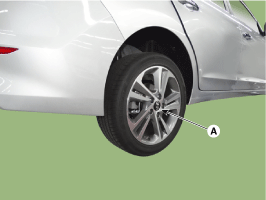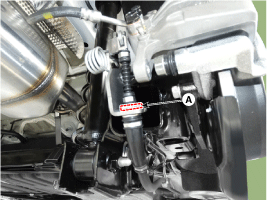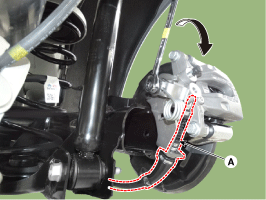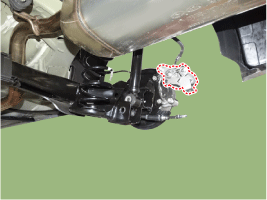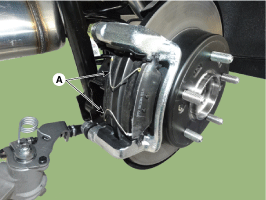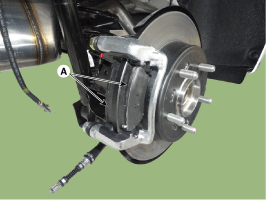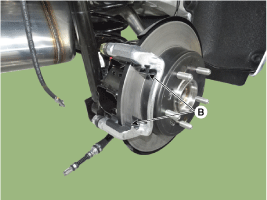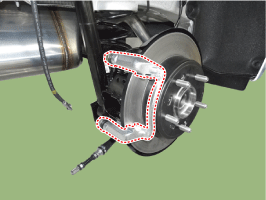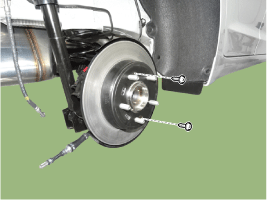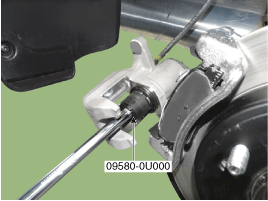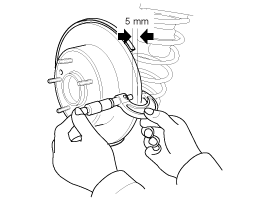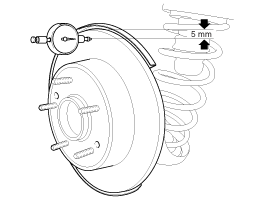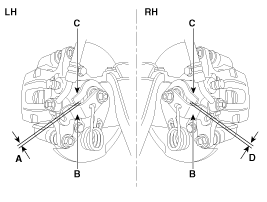Hyundai Elantra: Brake System / Rear Disc Brake Repair procedures
| Removal |
| 1. |
Loosen the wheel nuts slightly.
Raise the vehicle, and make sure it is securely supported. |
| 2. |
Remove the rear wheel and tire (A) from front hub .
|
| 3. |
Remove the parking brake cable fixed clip(A).
|
| 4. |
Pull the spanner as a below arrow in order to loosen the cable. And then remove the parking cable (A).
|
| 5. |
Loosen the guide rod bolt(B) and then pivot the caliper body (A) up out of the way.
|
| 6. |
Remove the pad return spring (A).
|
| 7. |
Separate the brake pad (A) and pad retainer (B).
|
| 8. |
Loosen the caliper mounting bolts and then removethe rear caliper assembly (A).
|
| 9. |
Remove the rear brake disc by loosening the screws.
|
| Replacement |
| 1. |
Remove the parking brake cable fixed clip(A).
|
| 2. |
Pull the spanner as a below arrow in order to loosen the cable and then remove the parking cable (A).
|
| 3. |
Loosen the guide rod bolt(B) and then pivot the caliper body (A) up out of the way.
|
| 4. |
Remove the pad return spring (A).
|
| 5. |
Replace the brake pad (A) and pad retainer.
|
| 6. |
Install the pad return spring (A).
|
| 7. |
Use a SST (09580-0U000) when installing the brake caliper assembly.
|
| 8. |
Install the caliper body(A) then tighten the guide rod bolt(B).
|
| 9. |
Pull the spanner as a below arrow in order to loosen the cable and then remove the parking cable (A).
|
| 10. |
Install the parking brake cable fixed clip(A).
|
| Inspection |
| Rear Brake Disc Thickness Check |
| 1. |
Check the brake pads for wear and fade. |
| 2. |
Check the brake disc for damage and cracks. |
| 3. |
Remove all rust and contamination from the surface, and
measure the disc thickness at 8 points, at least, of same distance (5mm)
from the brake disc outer circle.
|
| 4. |
If wear exceeds the limit, replace the discs and pad assembly left and right of the vehicle. |
| Rear Brake Pad Check |
| 1. |
Check the pad wear. Measure the pad thickness and replace it, if it is less than the specified value.
|
| 2. |
Check the damage of pad, backing metal and contamination with grease.
|
| Rear Brake Disc Runout Check |
| 1. |
Place a dial gauge about 5mm (0.2 in.) from the outer circumference of the brake disc, and measure the runout of the disc.
|
| 2. |
If the runout of the brake disc exceeds the limit specification, replace the disc, and then measure the runout again. |
| 3. |
If the runout exceeds the limit specification, install the
brake disc after turning it 180° and then check the runout of the brake
disc again. |
| 4. |
If the runout cannot be corrected by changing the position of the brake disc, replace the brake disc. |
| Installation |
| 1. |
To install, reverse the removal procedure. |
| 2. |
Use a SST (09580-0U000) when installing the brake caliper assembly.
|
| 3. |
After installing, bleed the brake system.
(Refer to Brake System -"Brake System Bleeding")
(Refer to Brake system - "ABS System Bleeding")
(Refer to Brake system - "ESP System Bleeding") |
| Parking Brake Adjustment |
|
| 1. |
Remove the floor console to reach the adjusting nut. |
| 2. |
Loosen the parking brake cable until both operating levers rest in fully off position. |
| 3. |
Bring the brake pads in their operating position by pressing the brake pedal down several times until there is resistance. |
| 4. |
Tension the parking brake cable by tightening the adjusting
nut, until the operating levers on both calipers lift from the stop, up
to a distance of (A) and (D) between operating lever (B) and stopper
(C).
|
| 5. |
Refit the floor console. |
| 6. |
Parking brake lever in the car must be in fully loosened position. |
| 7. |
If the handbrake cables where changed, actuate the parking
brake a few times with maximum force to stretch the parking brake
cables, and then control adjusting as above. |
| 8. |
Check the wheels of their free operation. |
| 9. |
Test drive. |
 Rear Disc Brake Components and Components Location
Rear Disc Brake Components and Components Location
Components
1. Brake pad2. Pad return spring3. Caliper carrier4. Pad retainer5. Caliper body6. Return spring7. Stopper8. Operating lever9. Bleed screw
...
 Rear Drum Brake Components and Components Location
Rear Drum Brake Components and Components Location
Components
1. Shoe hold down pin 2. Shoe adjuster 3. Upper return spring4. Adjusting lever5. Shoe6. Adjusting spring7. Lower return spring8. Shoe hold spring
...
Other information:
Hyundai Elantra AD (2016-2020) Service Manual: Refrigerant Line Repair procedures
Replacement
1.
If the compressor is marginally operable, run the engine at
idle speed, and let the air conditioning work for a few minutes, then
shut the engine off.
2.
Disconnect the negative (-) battery terminal.
3.
Recover the refrigerant with a recovery / charging station.
...
Hyundai Elantra AD (2016-2020) Service Manual: In-car Sensor Description and Operation
Description
The In-car air temperature sensor is built in the heater & A/C control unit.
The sensor contains a thermistor which measures the
temperature of the inside. The signal decided by the resistance value
which changes in accordance with perceived inside temperature, is
delivered ...

